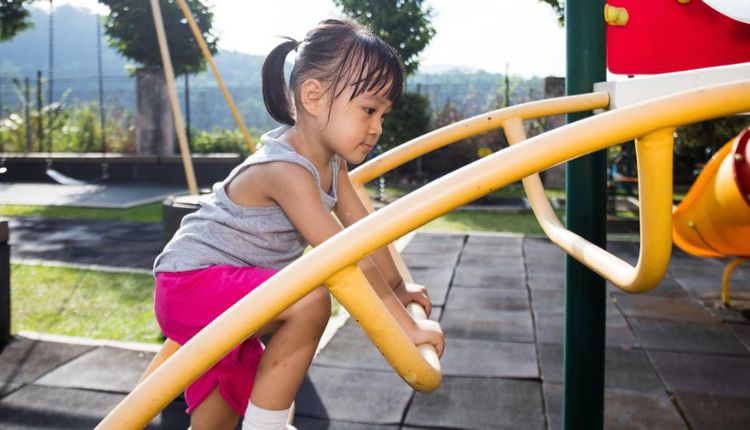Playgrounds offer children a healthy place to run, jump, climb and slide. However, injuries do occur. Make sure that there is impact attenuating surfacing underneath and around all equipment. It should be a softer material than the equipment itself and tested to ASTM F1292 standards. Watch for openings that can trap a child’s head or body, such as between bar rungs and under barriers. Also check that there is sufficient clearance for children going down slides to land safely.
Surfaces
Children play hard and fall down a lot, and it’s important that playground surfaces absorb shock and prevent injuries. A good surface is soft, springy and cushioned, reducing the force of falls. It should also be easily cleaned and not cluttered with debris or tripping hazards like rocks, sticks and tree branches. The best safety surfacing materials are unitary and easy to maintain, such as rubber tiles or safety tile. They offer great shock absorption, are ADA accessible, and are available in a variety of colors. These surfaces are more expensive than loose-fill options.
Safety tiling is made from a base layer of coarse recycled rubber (SBR) with a top layer or wearing coarse of EPDM rubber crumb. It’s one of the 안전놀이터 surfacing materials and has been tested to meet critical fall heights. It’s also a popular option for schools and is extremely durable. It is not recommended to install safety tiling over a concrete or asphalt subbase.
Equipment
It’s important to choose equipment that meets safety specifications. Many injuries occur when children use equipment designed for home or other public playgrounds that does not meet ASTM playground standards. Inspect the equipment regularly to be sure that it is secure and in good working order. Ensure that S-hooks on swings are closed and that no rope has slack greater than the thickness of a dime. Having a rope with too much slack can cause strangulation or entanglement.
Make sure that the surfacing under and around all equipment is cushioned with an adequate depth of engineered wood fiber, rubber mats, recycled material, poured-in-place rubber or synthetic turf. A deep surfacing material will also mitigate injury from falls. In addition, choose material that is impact-tested to ensure wheelchair accessibility. Guide children to age-appropriate equipment, as this will help keep them safe and avoid injury from improper equipment or a fall on a hard surface. Survey the entire playground to check for any apparent hazards.
Supervision
A safety playground requires constant supervision. It is impossible to be everywhere at once so adults supervising should be taught how to monitor kids from a distance, intercede when necessary and be on hand to handle injuries that may occur. Children must also be taught that they should follow established playground rules. A good rule is “wait your turn” to prevent accidents caused by kids jumping on the same equipment at the same time (slides, swings etc).
Finally, adults supervising the playground should position themselves so they can see the entire area. If obstructive elements like trees or other parts of the playground structure are in the way, they should be moved or removed. It is also important to ensure that the playground has been surveyed and all equipment is in good condition. It should be sanitized before and after playtime (be sure to follow Bloodborne Pathogens guidelines). Finally, the equipment should be separated by age so that kids aren’t on equipment that is too big for them.
Clothing
The playground is an ideal place for kids to burn off energy, make friends and learn how to interact with others. However, it’s important to keep in mind safety concerns when sending your children to play at the park. Ensure that children wear closed-toe shoes and avoid flip flops or bare feet. Clothing with drawstrings, purses, necklaces and pet leashes should be removed because they can catch on equipment and cause strangulation.
Use a playground with impact-absorbing surfaces such as rubber, wood chips, sand, pea gravel or shredded rubber to reduce the chances of serious injury. It’s also best to avoid playground equipment that’s installed over blacktop, concrete, dirt or grass, as these surfaces can become uncomfortably hot in the summertime and pose a serious burn risk. Teach children to slide feet-first on slides, not stand on them and to never climb outside the equipment’s guardrails. It’s also important for kids to play together in groups, so they can keep an eye on each other and signal if someone is in danger.
What’s Next?
Children need to climb, slide and swing to build strength and coordination. But if they aren’t playing in safe environments, they can become injured or even die. Many playground injuries occur when kids fall from equipment onto hard surfaces such as asphalt, dirt or grass. Look for soft surfacing like wood fiber or mulch, sand or pea gravel around the equipment.

